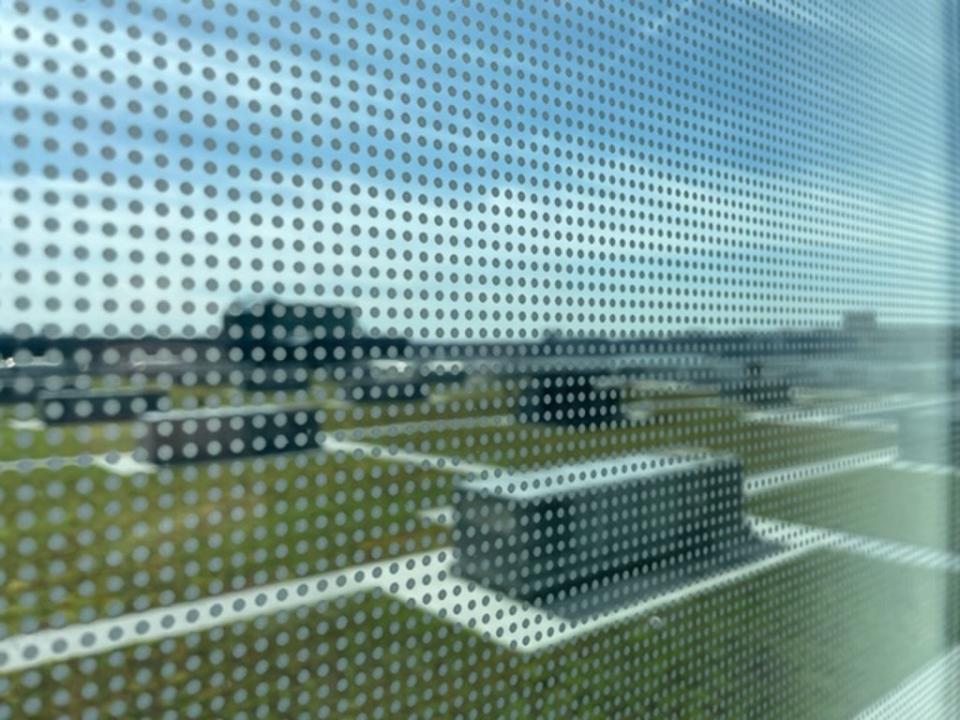From New York’s ‘number-one bird killer’ to wildlife haven: How the Javits Center went green
- Oops!Something went wrong.Please try again later.
- Oops!Something went wrong.Please try again later.
With its reputation as “New York’s No.1 bird killer”, the Javits Center isn’t the first place that springs to mind for conservation.
And yet the vast convention center in Manhattan has been transformed, not only into a haven for local wildlife, but an energy-efficient behemoth with the second-largest green roof in the country, and an urban farm to boot.
“We started on this journey with the green roof which led us down a path that was impossible to resist,” Alan Steel, president and CEO of the Javits Center, said last week during a visit by The Independent ahead of Earth Day. “Every time we did something that was green and sustainable, our customers asked us to do more so I think it shows a real interest in where we’re going.”
The convention center, named for the late Senator of New York Jacob Javits, sits off Manhattan’s West Side Highway overlooking the Hudson River.
This is where 2.5 million people trek every year for events like Comic Con, and the auto and travel shows, to name a few. Last year, it held a sustainability summit as part of New York Climate Week. And in November 2016, it was the scene of thousands of bereft Democrats at Hillary Clinton’s doomed election party.
In the past 10 years the Javits has had a $1.5bn facelift, and a 200,000 sq ft expansion with sustainability measures wrapped in. Ramping up the venue’s eco-credentials is part of a citywide effort as New York strives towards net-zero greenhouse gas emissions by 2050.
More than 3,000 solar panels will eventually give the Javits the largest rooftop solar farm in Manhattan, and offset the building's electric load. Since 2014, its also had a “green roof”, equivalent in size to five football fields.
A one-acre farm also sits on the rooftop, capable of growing 40,000 pounds of produce each year. It supplies “farm-to-table” ingredients for glitzy galas at the Javits, and the pre-packed salad clamshells in cafes several floors below.
But first, the birds.
Tony Sclafani, vice president and chief communications officer, concedes that the Javits was previously “the number one bird killer in New York City” due to its dark-mirrored glass, which also earned it the nickname “Darth Vader” among New Yorkers.
To combat its unfortunate avian reputation, new glass was installed during renovations. Each panel is covered in a pattern of dots, called “fritting”, which makes the glass less reflective and so, less likely for birds to fly directly into it. The glass has reduced bird collisions by 90 per cent.
In 2019, New York City adopted a law ruling that the fist 75ft of buildings must be constructed with materials visible to birds.
The glass panels’ added benefit is reducing heat inside the building, and have slashed Javits’ energy consumption by 26 per cent. It “translates into millions of dollars a year in savings,” Mr Sclafani says.
The green roof’s cooling impact also reduces what’s known as “urban heat island effect” in the area - with vegetation counteracting the absorbed heat of the concrete, glass and stainless steel city jungle.
The roof’s vegetative mats contain 14 different varieties of Sedum, leaf succulents that have water-storing leaves. The mats were grown for about a year on a farm in upstate New York before being transported to the city, and are specifically adapted to the regional climate.
The climate crisis is increasing rainfall in New York state, along with extreme weather events - as evident in the deadly storm Ida which battered the region last September and led to coastal storm surge and flash flooding.
“Green roofs in general are beneficial in preventing storm water run-off,” says Jacqueline Tran, director of energy and sustainability. “Especially in New York with combined sewer overflow this is really helpful.
“On average, 81 per cent of the rain that hits this roof, stays on the roof. That equates to about seven million gallons of stormwater run-off every year.”
By moderating stormwater runoff, the Javits green roof also improves water quality in the Hudson River.
A research team from New York City’s Cooper Union university also discovered in 2018 that the Javits’ green roof was more than 18 times as cost-effective as an underground cistern to collect and store an equivalent volume of stormwater in Midtown Manhattan.
The green roof was a relatively lo-fi part of Javits’ renovations as it has less than six inches of soil, so lightweight enough to need no additional structural support.

The urban farm is a little more hefty and needed bolstering for the 18 inches of soil in its raised plant beds, and three feet deep orchard.
The farm’s leafy greens, zucchini, cucumbers, and herbs, and 32 apple and pear trees of the orchard are tended by Brooklyn Grange, which operates a number of successful urban farms in the city.
The rooftop gardens have transformed the Javits into a haven for local wildlife. Some 35 bird species, five bat species, and thousands of insects have been observed by a steady stream of field trips.
In a 2014 study, by New York’s Audubon Society and Fordham University, Canada geese, American Kestrels, herring gulls, great black-backed gulls, rock pigeons, mourning doves, fish crows, barn swallows, northern mocking birds, European swallows and house swallows were spotted visiting the Javits.
And in a city of renowned for its archetypal WASPs, you can’t forget the bees.
In 2017, three hives were installed at the convention center. As honey bees will travel two to three miles to forage, it’s assumed that they are not only visiting the Javits green roof, but also the nearby, recently-extended High Line park and Hudson River Park.
Jars of their produce, sold as the aptly-named Jacob’s Honey, can be found in the convention center’s stores.

